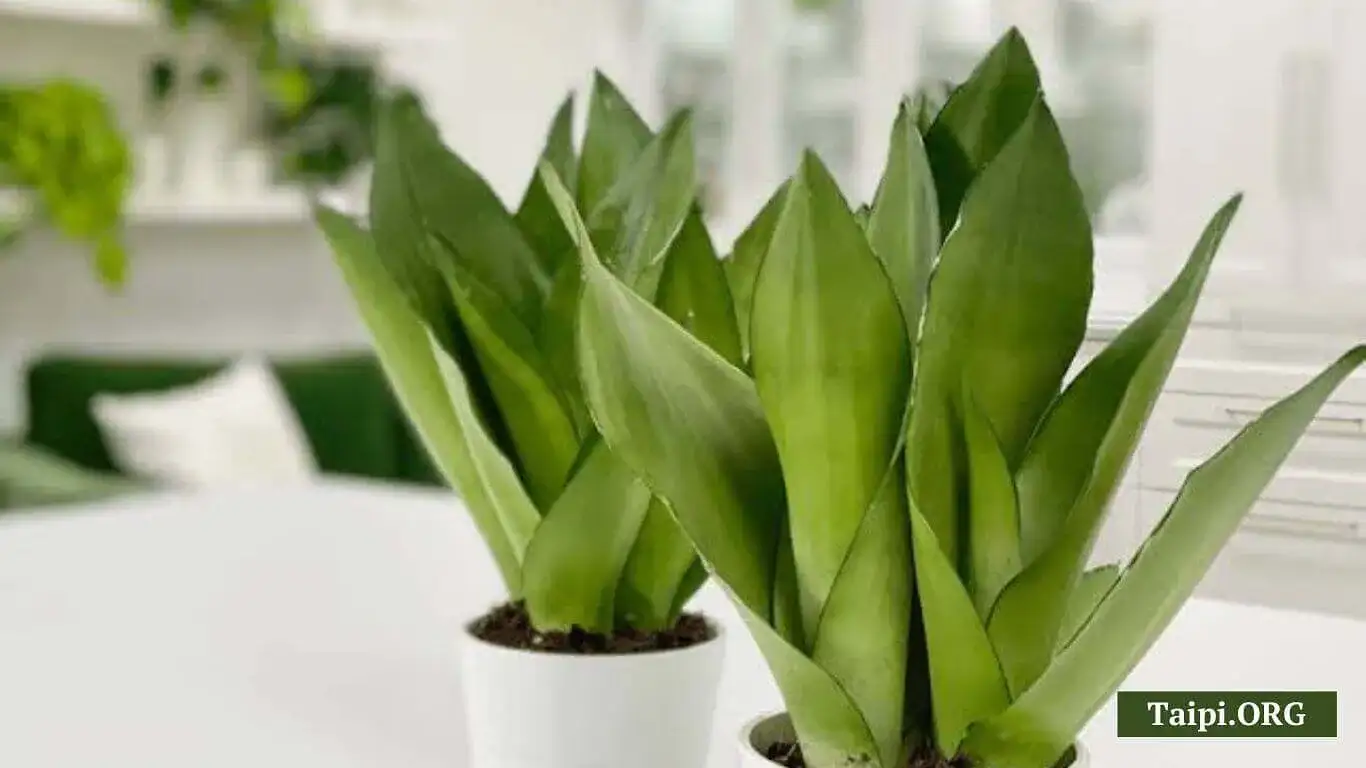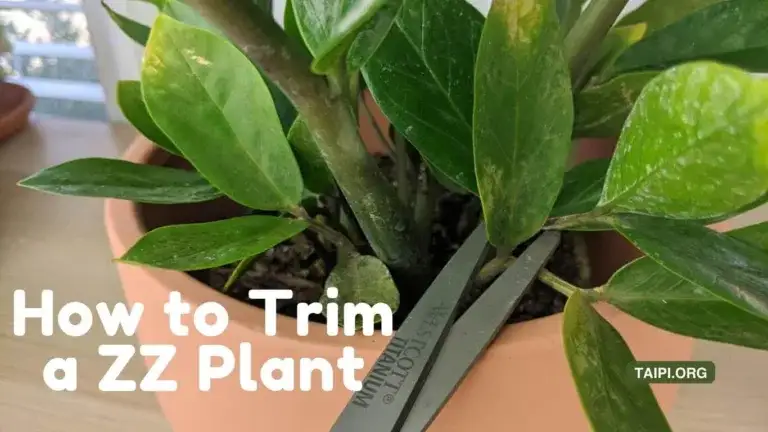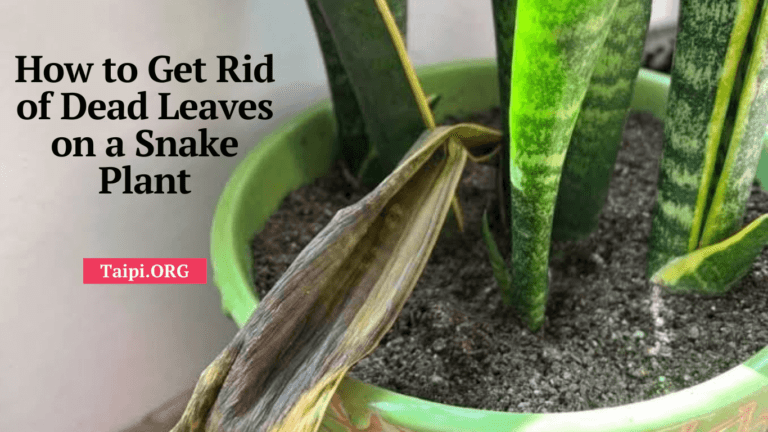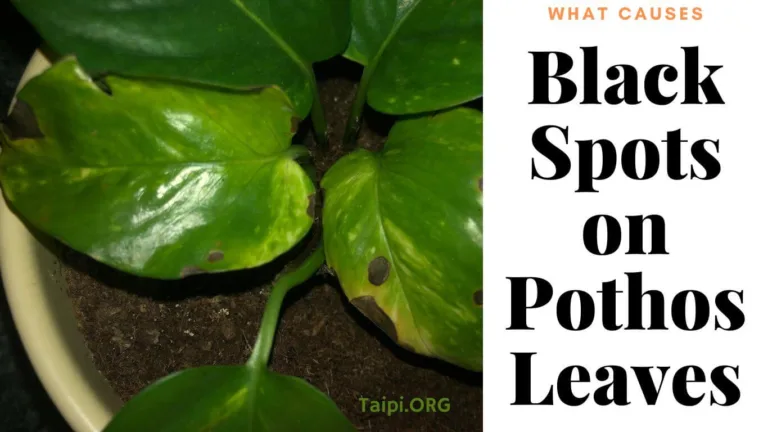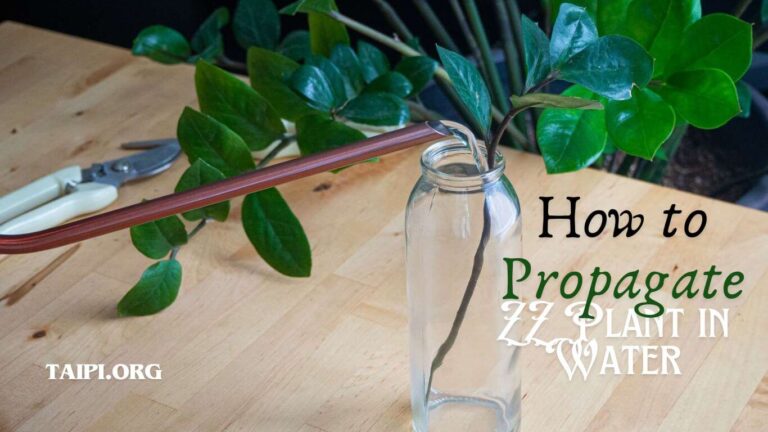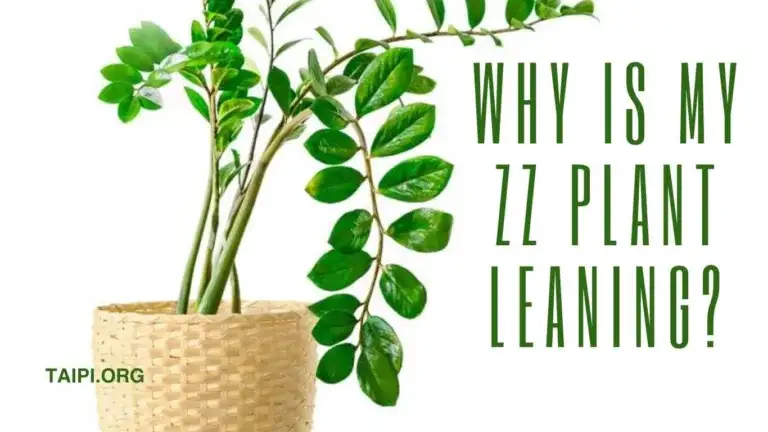How to Care for Moonshine Snake Plant
MOONSHINE Snake Plant (Sansevieria trifasciata), is a popular and stylish indoor plant that has captured the hearts of plant enthusiasts around the world. The plant is renowned for its unique appearance, ease of care, and air-purifying qualities, the Moonshine Snake Plant has become a favorite choice for both beginners and seasoned plant lovers.
In this article, I will delve into everything you need to know about the Moonshine Snake Plant, from its origin and characteristics to its care requirements and potential benefits. In addition, I will talk about Moonshine Snake Plant care in detail.
For now, here is something you need to know about the caring for a young Sansevieria Moonshine Snake Plant:
A young Moonshine Snake Plant requires medium to bright, indirect light. As the plant grows, it will withstand several hours of direct sunlight.
Origin and Characteristics
The Moonshine Snake Plant is a cultivar of the Sansevieria trifasciata, commonly known as the Snake Plant or Mother-in-law’s Tongue.
Native to West Africa, these plants have adapted to a variety of environments, making them resilient and well-suited for indoor spaces.
What sets the Moonshine variety apart is its striking silvery-green foliage, which gives it a modern and sophisticated aesthetic.
The leaves of the Moonshine Snake Plant are sword-shaped, upright, and can grow up to two to three feet in height.
They are pale green with subtle horizontal stripes, creating a moonlit appearance that lends the plant its name. This distinctive coloring makes it an excellent choice for contemporary and minimalist interior designs.
Care Requirements
One of the key reasons for the Moonshine Snake Plant’s popularity is its low maintenance and adaptability to different conditions. Here are some essential care tips for keeping your Moonshine Snake Plant healthy:
Light
Moonshine Snake Plants thrive in indirect light but can tolerate low light conditions. They can even adapt to some direct sunlight, although prolonged exposure to intense sunlight may cause leaf burn. Aim for moderate, filtered light for optimal growth.
Watering
These plants are drought-tolerant and are more likely to suffer from overwatering than underwatering. Allow the soil to dry out between waterings, and water sparingly during the winter months when the plant is in a dormant phase.
Well-draining soil is crucial to prevent root rot.
Temperature
Moonshine Snake Plants prefer temperatures between 70-90°F (21-32°C) during the day and can tolerate slightly cooler temperatures at night. Protect them from drafts and sudden temperature changes.
Soil
Like most snake plant varieties, Moonshine prefers a well-draining potting mix, such as a cactus mix or a mix specifically formulated for succulents. This helps prevent waterlogged soil, which can lead to root rot.
Benefits of Growing Moonshine Snake Plant Indoors
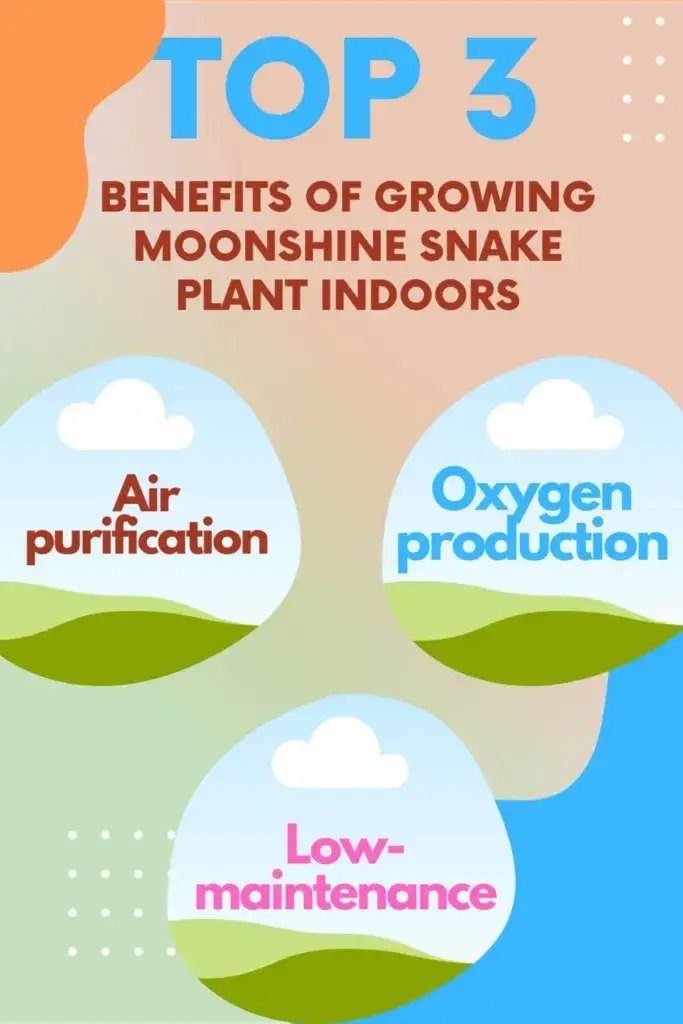
Aside from its aesthetic appeal and easy care, the Moonshine Snake Plant offers several benefits for indoor environments:
Air Purification
Like other varieties of Sansevieria, the Snake Plant Moonshine is known for its air-purifying properties. It can help remove toxins such as formaldehyde, benzene, and trichloroethylene from the air, promoting a healthier indoor environment.
Oxygen Production
Moonshine Snake Plants, like all plants, release oxygen during photosynthesis, contributing to improved air quality.
Low-Maintenance
The plant is ideal for busy individuals or those new to plant care. Moonshine Snake Plant requires minimal attention and can thrive in conditions that might be challenging for other houseplants.
Moonshine Snake Plant Care Pro Tips
Here are additional pro tips to ensure the optimal care of your Moonshine Snake Plant:
Lighting
While Moonshine Snake Plants can tolerate low light conditions, they will thrive in bright, indirect light.
Therefore, provide them with moderate to filtered sunlight for the best growth and leaf coloration.
However, avoid prolonged exposure to intense, direct sunlight, as it can lead to leaf burn or any other leaf-related complications.
Watering
Overwatering is a common issue with snake plants.
Allow the soil to dry out completely between waterings, and then water thoroughly.
It’s better to underwater than overwater, as these plants are adapted to survive in arid conditions. Reduce watering frequency during the dormant winter months.
Soil
Use a well-draining soil mix designed for succulents or cacti to prevent waterlogging.
Container Choice
Plant your Moonshine Snake Plant in a pot with drainage holes to prevent water from accumulating at the bottom. This reduces the risk of root rot, a common issue with snake plants.
Temperature and Humidity
Moonshine Snake Plants are adaptable to a range of temperatures, but they prefer warmer conditions.
Protect them from cold drafts, and avoid sudden temperature fluctuations. They can tolerate average indoor humidity levels, making them well-suited for most homes.
Fertilizing
Moonshine Snake Plants are not heavy feeders. Fertilize sparingly, usually once every 2-4 months during the growing season (spring and summer).
When feeding your Moonshine Snake Plants, use the best balanced, diluted fertilizer, and avoid over-fertilizing, as excessive nutrients can harm the plant.
Pruning
Trim any yellow or damaged leaves at the base using clean, sharp scissors or pruning shears. Regular pruning helps maintain the plant’s appearance and encourages healthy growth.
Pest Management
Moonshine Snake Plants are generally resistant to pests, but occasionally, they may attract mealybugs or spider mites. Inspect the plant regularly, and if pests are detected, treat them promptly with insecticidal soap or neem oil.
Repotting
Moonshine Snake Plants prefer slightly crowded conditions, so they don’t require frequent repotting. Repot when the plant has outgrown its container or if the soil has become depleted of nutrients.
Note: Spring is an ideal time for repotting.
Propagation
If you want to expand your collection or share the joy of Moonshine Snake Plants with friends, propagate through leaf cuttings or division.
Allow cuttings to callus before planting them in soil, and divide the plant carefully, ensuring each section has roots attached.
By following these pro tips, you’ll be well on your way to keeping your Moonshine Snake Plant healthy, vibrant, and a stunning addition to your indoor space.
Common Pests and Diseases That Attack the Moonshine Snake Plant
Moonshine Snake Plants are generally hardy and resistant to most pests and diseases.
However, like any indoor plant, they can occasionally face issues. Here are some common pests and diseases that might affect your Moonshine Snake Plant and how to address them.
I will start with pests:
Spider Mites
How to Identify Them: These are tiny, reddish-brown or yellowish pests that create fine webbing on the leaves.
Treatment: Regularly mist the plant to increase humidity. Wipe leaves with a damp cloth and use insecticidal soap or neem oil.
Mealybugs
How to Identify Them: Mealybugs are small, cotton-like white insects often found in leaf axils and along leaf margins.
Treatment: Remove mealybugs with a cotton swab dipped in rubbing alcohol. Use insecticidal soap or neem oil for severe infestations.
Scale Insects
How to Identify Them: These are hard, brown or tan scales on leaves, resembling small bumps.
Treatment: Remove scales manually with a soft brush or cloth. Apply insecticidal soap or neem oil.
Fungus Gnats
How to Identify Them: Fungus gnats are small, dark flies that hover around the soil surface.
Treatment: Allow the soil to dry between waterings, use sticky traps, and consider introducing beneficial nematodes to control larvae.
Now, let’s talk about diseases that are likely to attack your Moonshine Snake Plant.
Root Rot
Cause: Overwatering or poorly draining soil leads to fungal growth in the roots.
Prevention/Treatment: Use well-draining soil, allow the top inch of soil to dry between waterings, and ensure the pot has drainage holes. Trim affected roots and repot if necessary.
Leaf Spot
Cause: Fungal or bacterial infection causing dark spots on leaves.
Prevention/Treatment: Avoid overhead watering, ensure good air circulation, and remove affected leaves. Fungicidal sprays can be used in severe cases.
Bacterial Infections
Symptoms: Yellowing, wilting, or blackening of leaves.
Treatment: Remove affected parts, improve ventilation, and avoid overwatering. Copper-based fungicides may help in some cases.
Viral Infections
Symptoms: Stunted growth, mottled or distorted leaves.
Management: Viral infections have no cure. Remove and discard infected plants to prevent spreading. Maintain good hygiene practices to avoid transmission.
How to Prevent Your Moonshine Snake Plant from Pests and Diseases
The following are steps to prevent your Moonshine Snake Plant from pest and disease attacks:
Quarantine New Plants: Before introducing a new plant to your collection, isolate it for a few weeks to monitor for pests or diseases.
Well-Draining Soil: Use a well-draining potting mix to prevent waterlogged conditions that can lead to root rot.
Moderate Watering: Allow the soil to dry between waterings to prevent fungal growth and root issues.
Proper Ventilation: Ensure good air circulation around the plant to discourage the development of fungal and bacterial diseases.
Inspect Regularly: Regularly check your Moonshine Snake Plant for any signs of pests or diseases. Early detection allows for prompt treatment.
User
Common Problems with Moonshine Snake Plant
While Moonshine Snake Plants are generally resilient and low-maintenance, they can still encounter a few common problems. Here are some issues you might face with your Moonshine Snake Plant and how to address them:
Yellowing of Leaves
Cause: Overwatering is a common cause of yellow leaves. Inadequate light or old age can also contribute.
Solution: Allow the soil to dry between waterings. Ensure proper drainage and provide adequate light. Trim any yellow leaves at the base.
Root Rot
Cause: Overwatering or poorly draining soil can lead to root rot.
Solution: Allow the soil to dry out between waterings. Ensure the pot has drainage holes, and consider repotting in well-draining soil if root rot is severe.
Leaves Drooping
Cause: Underwatering, overwatering, or root issues can cause leaves to droop.
Solution: Check the soil moisture and adjust your watering accordingly. If the roots are healthy, the plant should recover with proper care.
Pest Infestations
Common Pests: Spider mites, mealybugs, and scale insects.
Solution: Regularly inspect the plant for pests. Wipe leaves with a damp cloth, and use insecticidal soap or neem oil for control.
Brown Tips or Edges
Cause: Dry air, low humidity, or fluoride in water can lead to browning.
Solution: Increase humidity by misting the plant or placing a tray of water nearby. Use distilled water or allow tap water to sit for a day before using it to reduce fluoride content.
Fungal Issues
Symptoms: Leaf spots or mushy stems may indicate fungal problems.
Solution: Improve air circulation, avoid overhead watering, and remove affected leaves. Fungicidal sprays can be used for severe cases.
Leggy Growth
Cause: Insufficient light can lead to stretching and leggy growth.
Solution: Move the plant to a brighter location with indirect light. Prune leggy growth to encourage a more compact form.
No New Growth
Cause: Lack of nutrients, low light, or the plant being root-bound.
Solution: Fertilize with a balanced, diluted fertilizer during the growing season. Ensure the plant has adequate light, and consider repotting if root-bound.
Pup Production
Cause: Lack of maturity or unfavorable growing conditions may slow down or prevent the development of new shoots (pups).
Solution: Ensure the plant is mature enough. Provide optimal growing conditions, including proper light and watering.
Leaf Curling
Cause: Leaves curling may be the plant’s response to environmental stress, pests, or insufficient water.
Solution: Address underlying issues, such as pests or improper watering. Ensure the plant is in optimal conditions for healthy growth.
How to Care for Moonshine Snake Plant FAQs
Q: How often should I water my Moonshine Snake Plant?
A: Moonshine Snake Plants prefer to dry out between waterings. Water sparingly, allowing the top inch of soil to dry before the next watering. During the dormant winter months, reduce the frequency of watering.
Q: Why are the leaves of my Moonshine Snake Plant turning yellow?
A: Yellowing leaves are often a sign of overwatering. Ensure the plant is in well-draining soil, and allow the soil to dry out between waterings. Trim any yellow leaves at the base to maintain the plant’s health.
Q: What is the best light conditions for Moonshine Snake Plants?
A: Moonshine Snake Plants thrive in bright, indirect light. They can tolerate low light conditions but prefer moderate to filtered sunlight. Avoid prolonged exposure to intense, direct sunlight, as it can lead to leaf burn.
Q: How do I propagate my Moonshine Snake Plant?
A: Moonshine Snake Plants can be propagated through leaf cuttings or division. For leaf cuttings, allow a cut end to callus before planting in well-draining soil. To divide the plant, carefully separate healthy sections with roots during repotting.
Q: Do Moonshine Snake Plants require fertilizer?
A: Moonshine Snake Plants are not heavy feeders. Fertilize sparingly with a balanced, diluted fertilizer during the growing season (spring and summer), typically every 2-4 months. Avoid over-fertilizing, as it can harm the plant.
Conclusion
The Moonshine Snake Plant is more than just a beautiful addition to your indoor space; it’s a resilient, low-maintenance companion that brings both style and health benefits to your home.
With its unique appearance and air-purifying qualities, the Moonshine Snake Plant is a fantastic choice for plant enthusiasts looking to enhance their living spaces with a touch of nature.
Whether you’re a beginner or an experienced plant parent, the Moonshine Snake Plant is sure to captivate you with its charm and ease of care.

